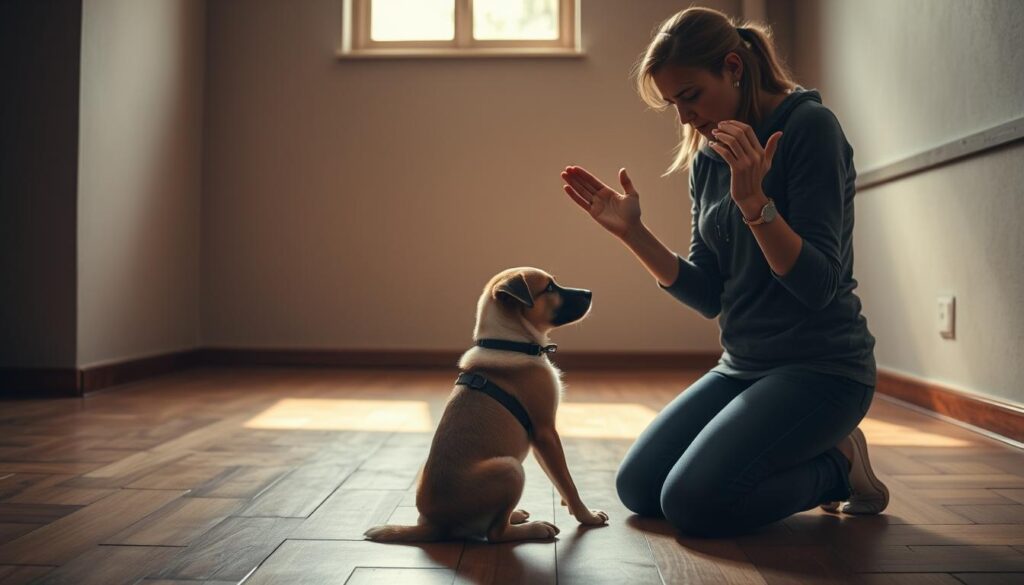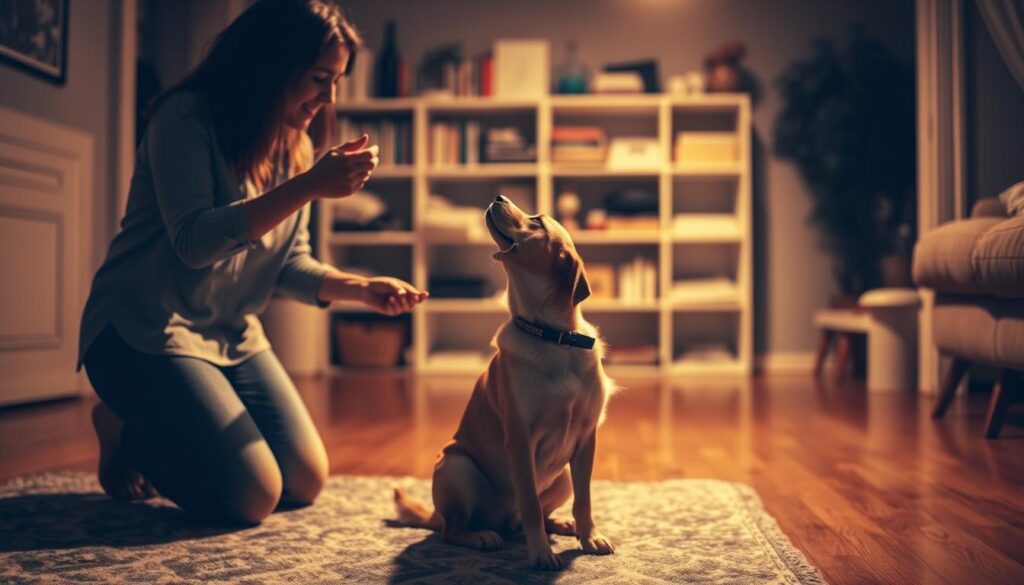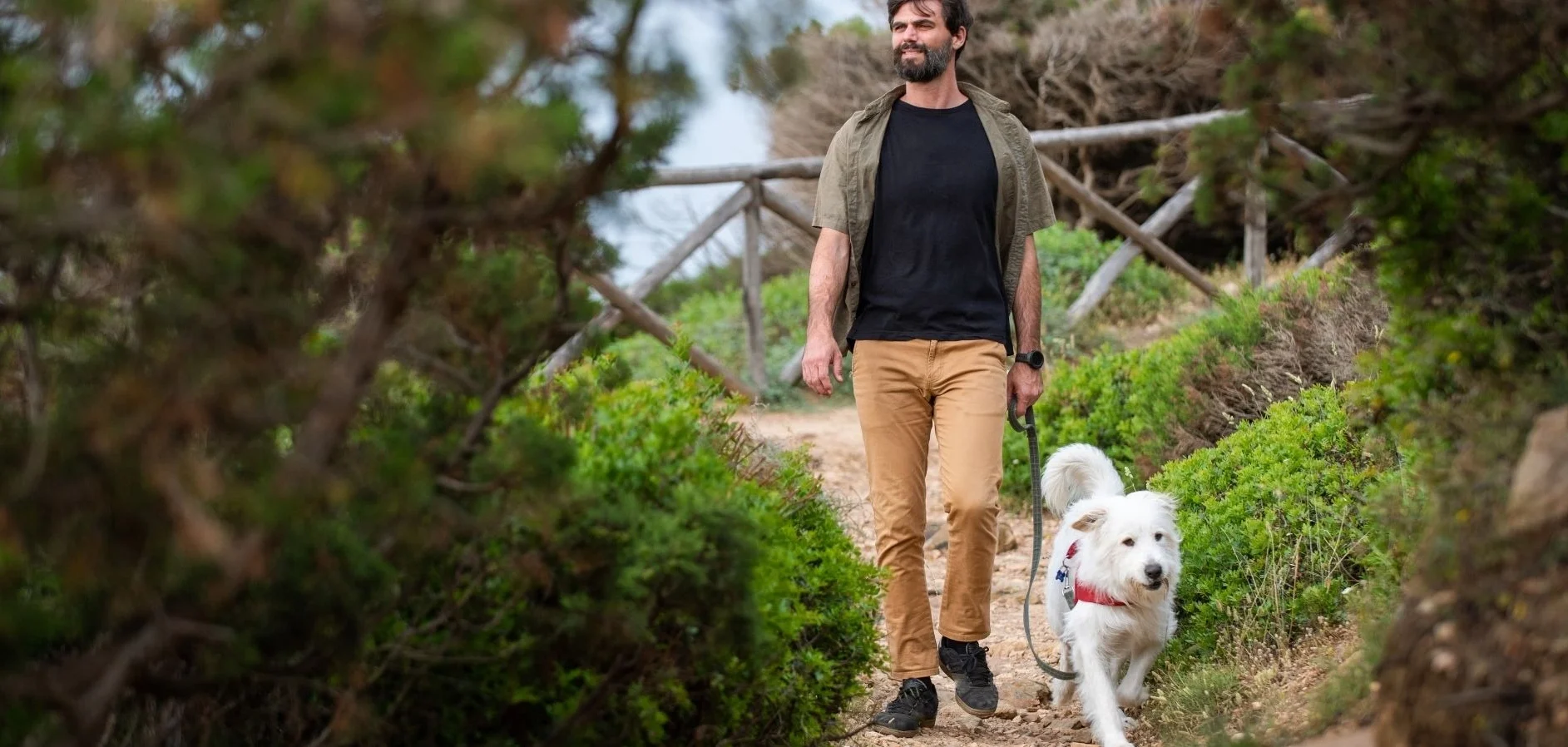How to Train a Dog to Sit with Love and Patience
Table of Contents
Every dog owner remembers that special moment when their pet learns a new command. For me, teaching my puppy to sit was more than just a lesson. It was about building a strong bond and understanding between us.
Learning how to train a dog to sit is not just about teaching a command. It’s about starting a new way of talking with your pet. These early moments are very important. They help create a lifelong bond of trust and friendship.
Whether you’re new to dog ownership or want to improve your training, mastering the sit command is key. It’s a simple yet powerful tool. It helps manage your dog’s behavior, keeps them safe, and brings you closer together.
Key Takeaways
- Sit command is crucial for puppy behavior and communication
- Training builds trust between you and your dog
- Consistent practice leads to successful learning
- Patience is key in dog training
- Positive reinforcement works best for teaching commands
Understanding the Importance of Sit and Stay Commands
Sit training is more than a simple trick. It’s a key skill that changes your bond with your dog. It makes your lives better by improving communication, safety, and understanding.
Dogs need clear guidance and structure. Sit training teaches them a language beyond words. It lays the groundwork for good behavior and helps them in social situations.
Benefits for Daily Life and Safety
Learning sit commands keeps your dog safe. Here are some safety benefits:
- Prevent your dog from darting into traffic
- Control behavior when guests arrive
- Manage interactions with other animals
- Reduce potential aggressive encounters
Building Trust and Communication
Teaching a dog to sit builds trust. Consistent training builds mutual respect. It helps your dog understand what you expect.
Effective communication starts with simple, clear commands that your dog can easily understand and follow.
Foundation for Advanced Training
Sit training is a key step to more advanced skills. Mastering this command prepares your dog for better training. It improves their skills and your bond.
- Develops impulse control
- Increases focus and attention
- Prepares for more complex commands
- Builds confidence in both dog and owner
Essential Supplies for Successful Training Sessions
Getting ready for dog training is more than just being excited. You need some important items to teach your dog to sit well. These items help make learning fun and effective.
The key tool for training is top-notch treats. They should be:
- Small and easy to eat fast
- Very appealing to your dog
- Soft for quick eating
- Good for your dog’s health
When teaching your dog to sit, pick treats that are irresistible to them. Soft, small treats are best for training. Stay away from big or hard treats that might confuse your dog.
You’ll also need more than just treats for successful training:
- A quiet place to train
- Comfortable clothes
- Patience
- A daily training time of 15-20 minutes
“The right environment and tools can transform sit training from challenging to enjoyable.” – Professional Dog Trainer
Remember, your attitude and being consistent are just as important as the tools. Being calm and positive helps your dog learn faster and enjoy training.
Creating the Perfect Training Environment
Starting with a great learning space is key for dogs to learn to sit. Your training area is important for your puppy to focus and learn new commands well.
Setting up the right place for training needs careful thought. You want to keep distractions low and help your dog focus better.
Selecting the Optimal Training Location
Look for a quiet spot in your home that’s just right. It should have:
- Minimal background noise
- Comfortable floor surface
- Good lighting
- Enough space for movement
Managing Training Distractions
It’s important to keep distractions away for effective training. Start in a quiet indoor spot. Then, slowly add small distractions.
| Distraction Level | Training Strategy |
|---|---|
| Low Distraction | Quiet room, few external sounds |
| Medium Distraction | Soft background noise, occasional movement |
| High Distraction | Multiple people, outdoor environments |
Establishing a Consistent Training Schedule
Make a routine for training that works well. Short, regular sessions are best for young dogs. Try for:
- 5-10 minute training blocks
- 2-3 sessions per day
- Consistent timing
- Positive, reward-based approach
Remember, patience and consistency are key to successful sit behavior modification for dogs.
How to Train a Dog to Sit
Teaching your dog to sit is a basic skill every owner should know. It requires patience, consistency, and the right methods. With a few simple steps, your dog can learn this important command.
First, get some treats that your dog loves. Choose small, soft treats that they can eat quickly. Make the training fun and rewarding for your dog.
- Get your dog’s attention with a treat in your hand
- Hold the treat close to your dog’s nose
- Slowly move the treat up and slightly back over the dog’s head
- As your dog’s head tilts back, their bottom will naturally lower
- The moment they sit, say “Sit” and immediately reward them
Timing is crucial in how to train a dog to sit successfully. Reward them the moment their bottom touches the ground. This links the action to the command and the reward.
| Training Technique | Key Points | Duration |
|---|---|---|
| Treat Luring | Use high-value treats | 5-10 minutes per session |
| Verbal Command | Say “Sit” clearly | Consistent repetition |
| Reward Timing | Immediate treat after sitting | Instant positive reinforcement |
Practice these steps in short, frequent sessions. Keep the area calm and free from distractions. With regular practice, your dog will learn the sit command quickly.
Mastering the Stay Command: Step-by-Step Guide
Teaching your dog to stay is a big step in dog training. It helps them learn self-control and improves your communication. This skill is vital for keeping your dog safe in many situations.
The stay command is built on the basic sit. It teaches your dog to stay still until you say it’s okay. You’ll need patience, consistent practice, and positive feedback to succeed.
Introducing the Stay Command
Here’s how to start your dog training sit command session:
- Ask your dog to sit in a quiet area
- Place your open palm in front of their face
- Say “stay” in a clear, firm voice
- Take one step back
- Reward immediately if they remain seated
Adding Duration to the Stay
Start by having your dog stay for short times. Then, slowly increase the time:
- Start with 2-3 seconds
- Gradually increase to 5-10 seconds
- Progressively add more time as your dog improves
- Always reward calm, consistent behavior
Teaching the Release Command
It’s important to have a clear release word. Choose a word like “okay” or “free” to tell your dog it’s okay to move. Practice this word often to help your dog learn the stay command.
Patience and positive reinforcement are key to successful stay training.
Common Training Mistakes to Avoid

Teaching a dog to sit might seem easy, but many owners face common issues. These problems can slow down your training. Spotting these mistakes early can change how you train and improve your bond with your dog.
- Rushing the Learning Process: Dogs need time to understand and master commands
- Inconsistent Reward Patterns: Sporadic treats confuse your dog’s learning
- Using Punishment-Based Techniques: Negative reinforcement damages trust
- Practicing in Limited Environments: Training should occur in various settings
Patience is key when teaching a dog to sit. Consistent, positive reinforcement helps your dog learn without feeling stressed or scared.
“Training is about communication, not domination.” – Professional Dog Trainer
Knowing common training challenges helps you create a better plan. Let’s look at some key mistakes to avoid in canine obedience sit training.
| Training Mistake | Negative Impact | Recommended Solution |
|---|---|---|
| Inconsistent Commands | Dog becomes confused | Use same verbal and hand signals |
| Short Training Sessions | Limited learning retention | Practice 5-10 minutes multiple times daily |
| Neglecting Positive Reinforcement | Reduced motivation | Use treats, praise, and gentle encouragement |
Successful dog training needs understanding, patience, and consistent practice. Each mistake is a chance to improve your training and bond with your dog.
Advanced Training Techniques and Progression
Once you’ve got the basics down, it’s time to take your dog’s training to the next level. Teach your dog to sit with more advanced techniques. These methods will challenge their skills and strengthen your bond.
As your dog gets better, you’ll want to add more complex scenarios. These will test their obedience and focus. Here are some techniques to help you move beyond basic sit commands:
Expanding Training Distance
Start by increasing the distance between you and your dog. Begin with small steps and gradually increase it:
- Begin 1-2 feet away from your dog
- Slowly increase distance to 5-10 feet
- Practice in various environments
- Use verbal and hand signals consistently
Managing Distractions
Training your dog to sit becomes harder with distractions. Here are some tips to improve their focus:
- Start with mild distractions
- Gradually introduce more complex environmental challenges
- Reward consistent performance
- Practice in progressively more stimulating settings
Combining Multiple Commands
Advanced training means combining different commands smoothly. Here’s how to create a comprehensive training plan:
| Command Combination | Training Approach | Difficulty Level |
|---|---|---|
| Sit-Stay-Come | Controlled recall while maintaining sit position | Intermediate |
| Sit-Down-Stand | Quick transition between positions | Advanced |
| Sit with Distraction | Maintaining sit during high-stimulus environments | Expert |
Remember, patience and consistent practice are crucial for advanced training. Every dog learns at their own pace. So, celebrate small victories and keep a positive, encouraging attitude.
Troubleshooting Training Challenges

Teaching your dog to sit and stay can be tricky. It needs patience and smart problem-solving. When problems come up, use positive reinforcement to help.
Dogs face many challenges in sit and stay training. Knowing these helps you create better training plans:
- Breaking the stay command too soon
- Getting distracted during training
- Not understanding release commands
- Not always responding to sit signals
Here are some ways to solve these problems:
| Challenge | Solution Strategy |
|---|---|
| Premature Stay Breaking | Start with short times, then increase, reward patience |
| High Distraction Levels | Train in environments that get more challenging |
| Inconsistent Command Response | Use clear, consistent verbal and hand signals |
Remember, every dog learns in their own way. Your training should fit your dog’s personality and how they learn. Stay calm and consistent to help your dog learn sit and stay.
Conclusion
Training your dog to sit and stay is a rewarding journey. It changes how you connect with your furry friend. Learning the dog training sit command helps you communicate better and understand each other.
Patience and consistency are key in this process. Every dog learns at their own pace. Celebrate each small win and keep using positive reinforcement.
Learning these commands is an investment in your dog’s life. They help build safety, trust, and a deeper bond. As you practice, you’ll see your dog respond better and your relationship grow stronger.
Keep practicing, stay positive, and enjoy the journey of dog training. Your hard work will turn these commands into a lifelong way to talk with your pet.
FAQ
How long does it typically take to teach a dog to sit?
Teaching a dog to sit depends on their age, breed, and how fast they learn. Most dogs can learn to sit in a few days to two weeks. Puppies might learn faster, while older dogs need more patience and practice.
What are the most effective treats to use for sit training?
The best treats for training are small and tasty. Think of small cooked chicken, cheese, or special training treats. They should be easy to eat quickly so they don’t interrupt your training.
Can older dogs learn to sit and stay?
Yes, older dogs can learn new commands too. Be patient and use positive reinforcement. Older dogs might need shorter, more frequent training sessions.
What if my dog won’t sit or seems uninterested in training?
If your dog is having trouble, try these tips:
– Use more appealing treats
– Keep training short (5-10 minutes)
– Train in a quiet place
– Use clear signals and commands
– Check for any discomfort
– If still struggling, consider a professional trainer
How often should I practice sit and stay commands?
Training should be consistent. Aim for 2-3 short sessions a day, each lasting 5-10 minutes. Practice in different places and with distractions. Regular practice reinforces the behavior.
Is it possible to teach sit and stay to a hyperactive dog?
Yes, it’s possible! Hyperactive dogs need patience and structured training. Start with short sessions, use high-value treats, and gradually increase the time. Exercise them before training and use positive reinforcement.
At what age can I start training my puppy to sit?
You can start training at 8 weeks old. Puppies can learn simple commands at this age. Keep sessions short, use lots of praise and treats, and make it fun. As they grow, you can make training more complex.
What if my dog sits but immediately stands up?
This is normal at first. To fix it:
– Reward them quickly when they sit
– Use a hand signal to help them stay
– Increase the time before rewarding
– Practice in short, consistent sessions
– Use high-value treats and positive reinforcement
– Be patient and consistent
There are no reviews yet. Be the first one to write one.


